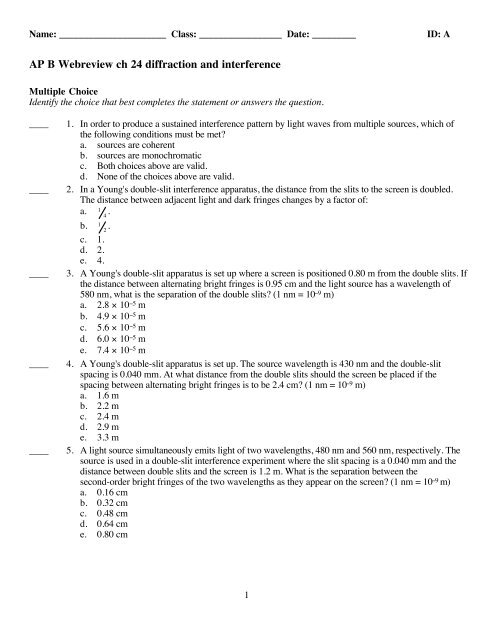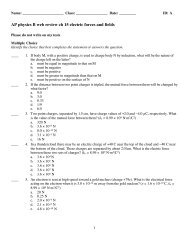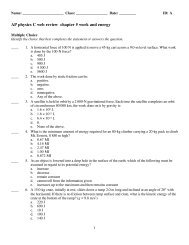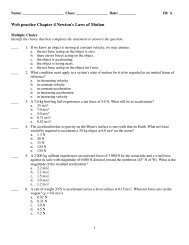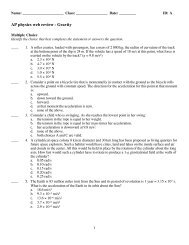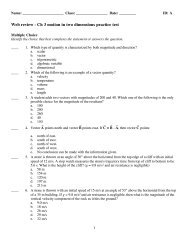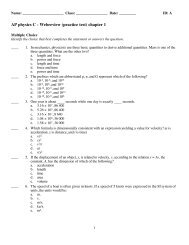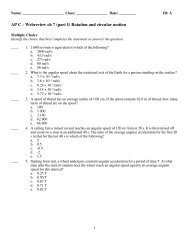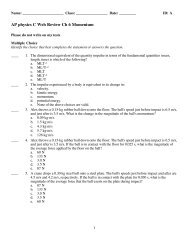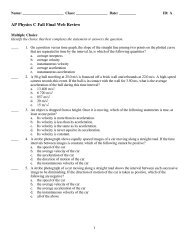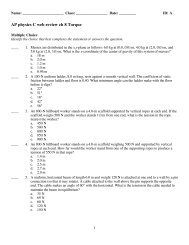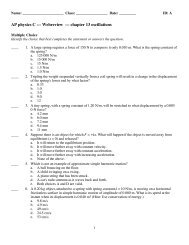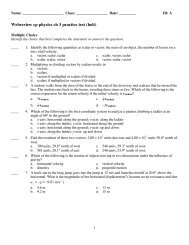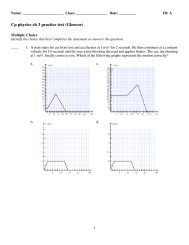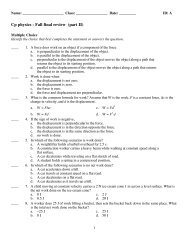AP B Webreview ch 24 diffraction and interference
AP B Webreview ch 24 diffraction and interference - Planet Holloway
AP B Webreview ch 24 diffraction and interference - Planet Holloway
- No tags were found...
Create successful ePaper yourself
Turn your PDF publications into a flip-book with our unique Google optimized e-Paper software.
Name: ______________________ Class: _________________ Date: _________<br />
ID: A<br />
<strong>AP</strong> B <strong>Webreview</strong> <strong>ch</strong> <strong>24</strong> <strong>diffraction</strong> <strong>and</strong> <strong>interference</strong><br />
Multiple Choice<br />
Identify the <strong>ch</strong>oice that best completes the statement or answers the question.<br />
____<br />
____<br />
____<br />
____<br />
____<br />
1. In order to produce a sustained <strong>interference</strong> pattern by light waves from multiple sources, whi<strong>ch</strong> of<br />
the following conditions must be met?<br />
a. sources are coherent<br />
b. sources are mono<strong>ch</strong>romatic<br />
c. Both <strong>ch</strong>oices above are valid.<br />
d. None of the <strong>ch</strong>oices above are valid.<br />
2. In a Young's double-slit <strong>interference</strong> apparatus, the distance from the slits to the screen is doubled.<br />
The distance between adjacent light <strong>and</strong> dark fringes <strong>ch</strong>anges by a factor of:<br />
a.<br />
1<br />
4<br />
.<br />
b.<br />
1<br />
2<br />
.<br />
c. 1.<br />
d. 2.<br />
e. 4.<br />
3. A Young's double-slit apparatus is set up where a screen is positioned 0.80 m from the double slits. If<br />
the distance between alternating bright fringes is 0.95 cm <strong>and</strong> the light source has a wavelength of<br />
580 nm, what is the separation of the double slits? (1 nm = 10 −9 m)<br />
a. 2.8 × 10 −5 m<br />
b. 4.9 × 10 −5 m<br />
c. 5.6 × 10 −5 m<br />
d. 6.0 × 10 −5 m<br />
e. 7.4 × 10 −5 m<br />
4. A Young's double-slit apparatus is set up. The source wavelength is 430 nm <strong>and</strong> the double-slit<br />
spacing is 0.040 mm. At what distance from the double slits should the screen be placed if the<br />
spacing between alternating bright fringes is to be 2.4 cm? (1 nm = 10 −9 m)<br />
a. 1.6 m<br />
b. 2.2 m<br />
c. 2.4 m<br />
d. 2.9 m<br />
e. 3.3 m<br />
5. A light source simultaneously emits light of two wavelengths, 480 nm <strong>and</strong> 560 nm, respectively. The<br />
source is used in a double-slit <strong>interference</strong> experiment where the slit spacing is a 0.040 mm <strong>and</strong> the<br />
distance between double slits <strong>and</strong> the screen is 1.2 m. What is the separation between the<br />
second-order bright fringes of the two wavelengths as they appear on the screen? (1 nm = 10 −9 m)<br />
a. 0.16 cm<br />
b. 0.32 cm<br />
c. 0.48 cm<br />
d. 0.64 cm<br />
e. 0.80 cm<br />
1
Name: ______________________<br />
ID: A<br />
____<br />
____<br />
____<br />
____<br />
____<br />
____<br />
6. Two beams of coherent light are shining on the same piece of white paper. With respect to the crests<br />
<strong>and</strong> troughs of su<strong>ch</strong> waves, darkness will occur on the paper where:<br />
a. the crest from one wave overlaps with the crest from the other.<br />
b. the crest from one wave overlaps with the trough from the other.<br />
c. the troughs from both waves overlap.<br />
d. darkness cannot occur as the two waves are coherent.<br />
e. darkness occurs anyway.<br />
7. If the 2nd order fringe in Young's double-slit experiment occurs at an angle of 45.0º, what is the<br />
relationship between the wavelength λ <strong>and</strong> the distance between slits, d?<br />
a. d = 1.41λ<br />
b. d = 2.00λ<br />
c. d = 2.83λ<br />
d. d = 4.00λ<br />
e. d = 5.66λ<br />
8. That light can undergo <strong>interference</strong> is evidence that it:<br />
a. has electric properties.<br />
b. is made of corpuscles.<br />
c. behaves like a wave.<br />
d. has a phase of 180º.<br />
e. behaves like a transversal wave.<br />
9. In a Young's experiment, the paths from the slits to a point on the screen differ in length causing<br />
constructive <strong>interference</strong> at the point. Whi<strong>ch</strong> of the following path difference would cause this<br />
constructive <strong>interference</strong>?<br />
a. 5λ/2<br />
b. 3λ/4<br />
c. 4λ<br />
d. 7λ/4<br />
e. none of the above<br />
10. Laser light sent through a double slit produces an <strong>interference</strong> patter on a screen 3.00 m from the<br />
slits. If the second order maximum occurs at an angle of 12.0°, at what angle does the eighth order<br />
maximum occur?<br />
a. No eighth order maximum occurs.<br />
b. 48.0°<br />
c. 56.3°<br />
d. 70.7°<br />
e. Not enough information is given.<br />
11. In a Young's double-slit experiment, how many maxima occur between the 4 th order maxima?<br />
a. 6<br />
b. 7<br />
c. 8<br />
d. 9<br />
e. Three more than the number of minima.<br />
2
Name: ______________________<br />
ID: A<br />
____ 12. The blue tint of a coated camera lens is largely caused by what effects?<br />
a. <strong>diffraction</strong><br />
b. refraction<br />
c. polarization<br />
d. <strong>interference</strong><br />
e. absorption<br />
____ 13. The dark spot observed in the center of a Newton's rings pattern is attributed to whi<strong>ch</strong> of the<br />
following?<br />
a. polarization of light when reflected<br />
b. polarization of light when refracted<br />
c. phase shift of light when reflected<br />
d. phase shift of light when refracted<br />
e. None of the above<br />
____ 14. What wavelength mono<strong>ch</strong>romatic source in the visible region (390 to 710 nm) can be used to<br />
constructively reflect off a soap film (n = 1.46) if the film is 77 nm thick?<br />
a. 409 nm<br />
b. 430 nm<br />
c. 450 nm<br />
d. 558 nm<br />
e. 627 nm<br />
____ 15. A silicon monoxide (n = 1.45) film of 100 nm thickness is used to coat a glass camera lens (n =<br />
1.56). What wavelength of light in the visible region (390 to 710 nm) will be most efficiently<br />
transmitted by this system? (1 nm = 10 −9 m)<br />
a. 400 nm<br />
b. 492 nm<br />
c. 6<strong>24</strong> nm<br />
d. 580 nm<br />
e. 505 nm<br />
____ 16. A silicon monoxide (n = 1.45) film of 270 nm thickness is used to coat a glass camera lens (n =<br />
1.56). What wavelength of light in the visible region (390 to 710 nm) will be most efficiently<br />
transmitted by this system? (1 nm = 10 −9 m)<br />
a. 409 nm<br />
b. 492 nm<br />
c. 522 nm<br />
d. 638 nm<br />
e. 700 nm<br />
____ 17. A beam of light of wavelength 650 nm is incident along the normal to two closely spaced parallel<br />
glass plates. For what air gap separation between the plates will the transmitted beam be of maximum<br />
intensity? (1 nm = 10 −9 m)<br />
a. 81 nm<br />
b. 163 nm<br />
c. 325 nm<br />
d. 488 nm<br />
e. 650 nm<br />
3
Name: ______________________<br />
ID: A<br />
____<br />
____<br />
____<br />
____<br />
18. When light shines on a lens placed on a flat piece of glass, <strong>interference</strong> occurs whi<strong>ch</strong> causes circular<br />
fringes called Newton's rings. The two beams that are interfering come:<br />
a. from the top <strong>and</strong> bottom surface of the lens.<br />
b. from the top surface of the lens <strong>and</strong> the top surface of the piece of glass.<br />
c. from the bottom surface of the lens <strong>and</strong> the top surface of the piece of glass.<br />
d. from the top <strong>and</strong> bottom surface of the flat piece of glass.<br />
e. from the top surface of the lens <strong>and</strong> the bottom surface of the piece of glass.<br />
19. A soap bubble (n = 1.35) is floating in air. If the thickness of the bubble wall is 300 nm, whi<strong>ch</strong> of the<br />
following wavelengths of visible light is strongly reflected?<br />
a. 620 nm (red)<br />
b. 580 nm (yellow)<br />
c. 540 nm (green)<br />
d. 500 nm (blue)<br />
e. 400 nm (violet)<br />
20. Two thin layers of material with different indices of refraction are coated on a glass plate. The outer<br />
first material has n1 = 1.404, the inner second material has n2 = 1.531, <strong>and</strong> the glass has nglass = 1.62.<br />
If light is incident from air on the first layer, what is the phase <strong>ch</strong>ange for light that reflects from the<br />
glass?<br />
a. 0°<br />
b. 180°<br />
c. 360°<br />
d. 540°<br />
e. 630°<br />
21. A Fraunhofer <strong>diffraction</strong> pattern is created by mono<strong>ch</strong>romatic light shining through whi<strong>ch</strong> of the<br />
following?<br />
a. single slit<br />
b. double slit<br />
c. triple slit<br />
d. more than 3 slits<br />
e. any number of slits<br />
4
ID: A<br />
<strong>AP</strong> B <strong>Webreview</strong> <strong>ch</strong> <strong>24</strong> <strong>diffraction</strong> <strong>and</strong> <strong>interference</strong><br />
Answer Section<br />
MULTIPLE CHOICE<br />
1. C<br />
2. D<br />
3. B<br />
4. B<br />
5. C<br />
6. B<br />
7. C<br />
8. C<br />
9. C<br />
10. C<br />
11. B<br />
12. D<br />
13. C<br />
14. C<br />
15. D<br />
16. C<br />
17. C<br />
18. C<br />
19. C<br />
20. B<br />
21. A<br />
1


